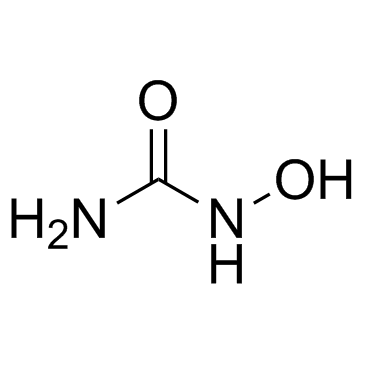羟基脲

羟基脲结构式

|
常用名 | 羟基脲 | 英文名 | Hydroxyurea |
|---|---|---|---|---|
| CAS号 | 127-07-1 | 分子量 | 76.055 | |
| 密度 | 1.5±0.1 g/cm3 | 沸点 | 222.1±23.0 °C at 760 mmHg | |
| 分子式 | CH4N2O2 | 熔点 | 135-140 °C | |
| MSDS | 中文版 | 闪点 | 88.1±22.6 °C | |
| 符号 |

GHS08 |
信号词 | Danger |
|
Rad23 interaction with the proteasome is regulated by phosphorylation of its ubiquitin-like (UbL) domain.
J. Mol. Biol. 426(24) , 4049-60, (2014) Rad23 was identified as a DNA repair protein, although a role in protein degradation has been described. The protein degradation function of Rad23 contributes to cell cycle progression, stress response, endoplasmic reticulum proteolysis, and DNA repair. Rad23... |
|
|
A gemcitabine sensitivity screen identifies a role for NEK9 in the replication stress response.
Nucleic Acids Res. 42(18) , 11517-27, (2014) The Replication Stress Response (RSR) is a signaling network that recognizes challenges to DNA replication and coordinates diverse DNA repair and cell-cycle checkpoint pathways. Gemcitabine is a nucleoside analogue that causes cytotoxicity by inducing DNA rep... |
|
|
Celastrol induces proteasomal degradation of FANCD2 to sensitize lung cancer cells to DNA crosslinking agents.
Cancer Sci. 106 , 902-8, (2015) The Fanconi anemia (FA) pathway plays a key role in interstrand crosslink (ICL) repair and maintenance of the genomic stability, while inhibition of this pathway may sensitize cancer cells to DNA ICL agents and ionizing radiation (IR). The active FA core comp... |
|
|
Pat1 protects centromere-specific histone H3 variant Cse4 from Psh1-mediated ubiquitination.
Mol. Biol. Cell 26 , 2067-79, (2015) Evolutionarily conserved histone H3 variant Cse4 and its homologues are essential components of specialized centromere (CEN)-specific nucleosomes and serve as an epigenetic mark for CEN identity and propagation. Cse4 is a critical determinant for the structur... |
|
|
Functional Genetic Screen Identifies Increased Sensitivity to WEE1 Inhibition in Cells with Defects in Fanconi Anemia and HR Pathways.
Mol. Cancer Ther. 14 , 865-76, (2015) WEE1 kinase regulates CDK1 and CDK2 activity to facilitate DNA replication during S-phase and to prevent unscheduled entry into mitosis. WEE1 inhibitors synergize with DNA-damaging agents that arrest cells in S-phase by triggering direct mitotic entry without... |
|
|
EZH2 modulates angiogenesis in vitro and in a mouse model of limb ischemia.
Mol. Ther. 23(1) , 32-42, (2015) Epigenetic mechanisms may regulate the expression of pro-angiogenic genes, thus affecting reparative angiogenesis in ischemic limbs. The enhancer of zest homolog-2 (EZH2) induces thtrimethylation of lysine 27 on histone H3 (H3K27me3), which represses gene tra... |
|
|
Rio1 promotes rDNA stability and downregulates RNA polymerase I to ensure rDNA segregation.
Nat. Commun. 6 , 6643, (2015) The conserved protein kinase Rio1 localizes to the cytoplasm and nucleus of eukaryotic cells. While the roles of Rio1 in the cytoplasm are well characterized, its nuclear function remains unknown. Here we show that nuclear Rio1 promotes rDNA array stability a... |
|
|
Cheminformatics analysis of assertions mined from literature that describe drug-induced liver injury in different species.
Chem. Res. Toxicol. 23 , 171-83, (2010) Drug-induced liver injury is one of the main causes of drug attrition. The ability to predict the liver effects of drug candidates from their chemical structures is critical to help guide experimental drug discovery projects toward safer medicines. In this st... |
|
|
Translating clinical findings into knowledge in drug safety evaluation--drug induced liver injury prediction system (DILIps).
J. Sci. Ind. Res. 65(10) , 808, (2006) Drug-induced liver injury (DILI) is a significant concern in drug development due to the poor concordance between preclinical and clinical findings of liver toxicity. We hypothesized that the DILI types (hepatotoxic side effects) seen in the clinic can be tra... |
|
|
Developing structure-activity relationships for the prediction of hepatotoxicity.
Chem. Res. Toxicol. 23 , 1215-22, (2010) Drug-induced liver injury is a major issue of concern and has led to the withdrawal of a significant number of marketed drugs. An understanding of structure-activity relationships (SARs) of chemicals can make a significant contribution to the identification o... |